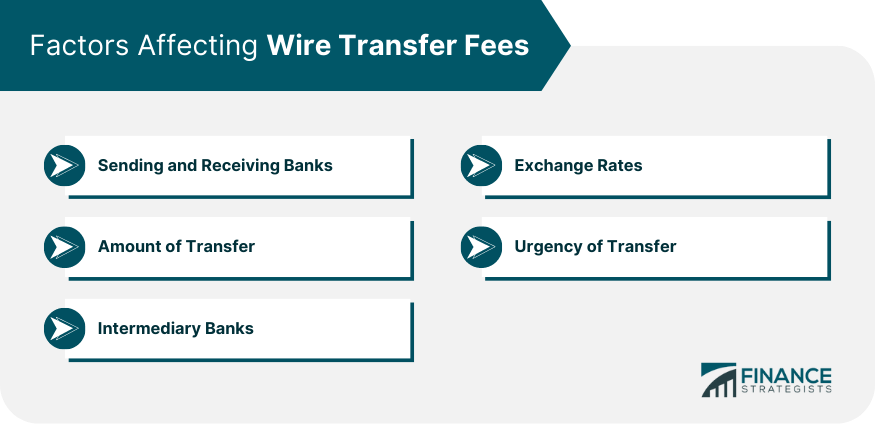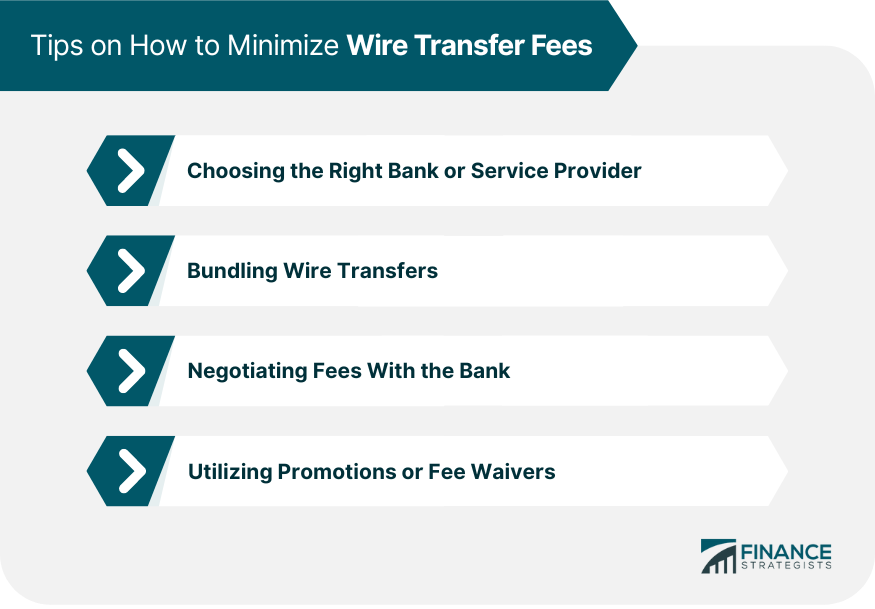Wire transfer fees are charges imposed by financial institutions for the transfer of funds from one account to another through a wire transfer. Wire transfers are electronic transactions that allow for the quick and secure transfer of money between banks or financial institutions, both domestically and internationally. When initiating a wire transfer, the sender's financial institution typically charges a fee to cover the administrative costs and processing services involved in executing the transfer. These fees can vary depending on the financial institution, the amount being transferred, the destination country, and the type of wire transfer (domestic or international). Wire transfer fees may include the following components: 1. Outgoing Wire Transfer Fee: This fee is charged by the sender's financial institution for processing the wire transfer. The amount can be a flat fee or a percentage of the transferred amount. 2. Incoming Wire Transfer Fee: The recipient's financial institution may also charge a fee for receiving the wire transfer. Similar to the outgoing fee, this can be a flat fee or a percentage of the received amount. 3. Intermediary Bank Fees: In some cases, when funds are transferred internationally, an intermediary bank may be involved in the transaction. These banks may charge fees for their role in facilitating the transfer, such as converting currencies or routing the funds. It's important to note that wire transfer fees can vary significantly between financial institutions. Some institutions may offer lower fees or even waive them for certain types of accounts, such as premium or high-value accounts. Additionally, fees for international wire transfers are generally higher compared to domestic transfers due to the additional complexities and regulations involved. Domestic wire transfer fees are charges applied to transfers within the same country. These fees vary depending on the bank or financial institution and can be a flat rate or a percentage of the transferred amount. International wire transfer fees apply when funds are sent between banks in different countries. These fees are typically higher than domestic fees due to the complexities of cross-border transactions, currency conversions, and the involvement of intermediary banks. Recurring wire transfer fees are charges associated with setting up and maintaining regular, scheduled transfers between banks. These fees can be a one-time setup cost or an ongoing charge, depending on the financial institution's policies. The fees for wire transfers are determined by both the sending and receiving banks. Each institution sets its own fee structure, which may include flat fees, percentage-based fees, or a combination of both. When transferring funds internationally, exchange rates can impact the total cost of the transaction. Banks and financial institutions may charge a margin on the exchange rate, which is added to the wire transfer fee. Some banks charge higher fees for larger transfer amounts. This can be a flat fee for transactions above a certain threshold or a percentage of the total amount being transferred. Urgent or same-day wire transfers usually come with higher fees than standard transfers, which can take several days to process. In some cases, especially for international wire transfers, intermediary banks are involved in the transaction. These banks may also charge fees, adding to the total cost of the wire transfer. Traditional banks often charge higher wire transfer fees compared to other financial institutions, as they maintain physical branches and extensive infrastructure. Fees can vary significantly between banks, making it important to compare costs before initiating a wire transfer. Credit unions typically offer lower wire transfer fees compared to traditional banks, as they are not-for-profit institutions focused on serving their members. However, they may have fewer international partnerships and limited wire transfer capabilities. Online banks, which operate without physical branches, can offer competitive wire transfer fees due to lower overhead costs. They may also provide better exchange rates and faster transfer times. Third-party money transfer services, such as PayPal, TransferWise, or Western Union, can offer lower fees and better exchange rates than traditional banks. These services specialize in transferring funds, making them an attractive option for cost-conscious consumers. By comparing fees among banks and third-party providers, consumers can find the most cost-effective option for their wire transfer needs. Some banks and providers offer discounts for bundling multiple wire transfers, which can help reduce fees for businesses or individuals who send funds regularly. Some banks may be willing to negotiate lower wire transfer fees, especially for high-value clients or those with long-standing relationships with the institution. Banks and third-party providers may offer promotions or fee waivers for certain types of wire transfers or new customers, making it worthwhile to keep an eye on available offers and discounts. Electronic funds transfers are a more cost-effective alternative to wire transfers for domestic transactions. These transfers are processed through an electronic network, which can be faster and less expensive than traditional wire transfers. Automated Clearing House transfers are another option for domestic transfers, enabling individuals and businesses to send funds electronically. ACH transfers are typically slower than wire transfers but come with lower fees, making them a popular choice for recurring payments or non-urgent transactions. Peer-to-peer payment platforms, such as Venmo, Zelle, or Cash App, allow users to send money directly to others without the involvement of a bank. These services typically have low or no fees for domestic transactions, making them an attractive alternative to wire transfers. Cryptocurrency transfers, such as Bitcoin or Ethereum, offer a decentralized way to send and receive funds without relying on traditional banks. While these transfers can have low fees and fast processing times, they also come with additional risks and regulatory concerns. Governments and regulatory bodies may impose rules and restrictions on wire transfer fees to protect consumers and ensure fair competition among financial institutions. These regulations can affect the fees that banks and third-party providers charge for their services. Consumer protection laws are designed to safeguard consumers from unfair or deceptive practices related to wire transfer fees. These laws may require financial institutions to disclose fees clearly and transparently, allowing consumers to make informed decisions when using wire transfers. Banks and financial institutions are subject to strict anti-money laundering AML and counter-terrorism financing regulations, which aim to prevent the use of wire transfers for illegal activities. These regulations can impact the fees associated with wire transfers, as banks may pass on the costs of compliance to their customers. Wire transfer fees are an important aspect to consider when sending and receiving funds through banks and financial institutions. These fees are influenced by various factors, including the type of transfer, the institutions involved, exchange rates, and regulatory requirements. By comparing fees among traditional banks, credit unions, online banks, and third-party providers, consumers can find cost-effective options for their wire transfer needs. Minimizing fees can be achieved by choosing the right provider, bundling transfers, negotiating with banks, and utilizing promotions. Moreover, understanding alternative methods such as EFT, ACH transfers, P2P platforms, and cryptocurrency transfers can offer additional cost-saving opportunities. Awareness of government regulations, consumer protection laws, and AML and CTF requirements is also essential to ensure compliance and make informed decisions regarding wire transfers.What Are Wire Transfer Fees?
Components of Wire Transfer Fees
Types of Wire Transfer Fees
Domestic Wire Transfer Fees
International Wire Transfer Fees
Recurring Wire Transfer Fees
Factors Affecting Wire Transfer Fees

Sending and Receiving Banks
Exchange Rates
Amount of Transfer
Urgency of Transfer
Intermediary Banks
Comparison of Wire Transfer Fees Among Banks
Traditional Banks
Credit Unions
Online Banks
Third-Party Money Transfer Services
How to Minimize Wire Transfer Fees

Choosing the Right Bank or Service Provider
Bundling Wire Transfers
Negotiating Fees With the Bank
Utilizing Promotions or Fee Waivers
Alternatives to Wire Transfers
Electronic Funds Transfers (EFT)
Automated Clearing House (ACH) Transfers
Peer-To-Peer (P2P) Payment Platforms
Cryptocurrency Transfers
Legal and Regulatory Aspects of Wire Transfer Fees
Government Regulations on Wire Transfer Fees
Consumer Protection Laws
Anti-money Laundering (AML) and Counter-Terrorism Financing (CTF) Regulations
Conclusion
Wire Transfer Fees FAQs
The wire transfer fee depends on factors such as the sending and receiving banks, exchange rates, the amount of the transfer, the urgency of the transfer, and the involvement of intermediary banks.
Domestic wire transfer fees are usually lower than international fees, as international transactions involve currency conversions, cross-border complexities, and often require the involvement of intermediary banks.
To minimize wire transfer fees, consider choosing the right bank or service provider with lower fees, bundling wire transfers, negotiating fees with your bank, and utilizing promotions or fee waivers.
Yes, alternatives to wire transfers include electronic funds transfers (EFT), Automated Clearing House (ACH) transfers, peer-to-peer (P2P) payment platforms, and cryptocurrency transfers. These options may have lower fees compared to traditional wire transfers.
Government regulations and consumer protection laws can affect wire transfer fees by imposing rules on fee structures, requiring transparent fee disclosure, and ensuring fair competition among financial institutions. Additionally, anti-money laundering (AML) and counter-terrorism financing (CTF) regulations can impact fees, as banks may pass on compliance costs to customers.
True Tamplin is a published author, public speaker, CEO of UpDigital, and founder of Finance Strategists.
True is a Certified Educator in Personal Finance (CEPF®), author of The Handy Financial Ratios Guide, a member of the Society for Advancing Business Editing and Writing, contributes to his financial education site, Finance Strategists, and has spoken to various financial communities such as the CFA Institute, as well as university students like his Alma mater, Biola University, where he received a bachelor of science in business and data analytics.
To learn more about True, visit his personal website or view his author profiles on Amazon, Nasdaq and Forbes.













